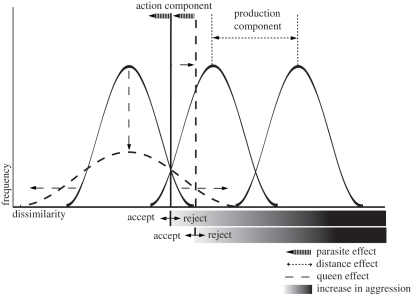Figure 1.
Frequency distribution of cue dissimilarities between the actor template (left of acceptance threshold) and recipients (non-nest-mates) phenotype (right of the acceptance threshold). Queen effect (dashed lines) causes the cue dissimilarity distribution (CDD) to broaden and as a result to shift the acceptance threshold to the right in order to avoid rejection errors (rejection of nest-mates); at the same time, with the right shift the risk of acceptance errors (acceptance of non-nest-mates) increases. Social parasites can take advantage of this ‘open door’. In order to avoid social parasites, the threshold needs to be set to more restrictive values (action component; dashed arrow). With increasing distance (physically, chemically or genetically; dotted lines) overlaps between template CDD and recipient phenotype CDD are lower, since the CDDs diverge (production component) and it becomes safer to unleash higher aggression towards an encountered recipient.

